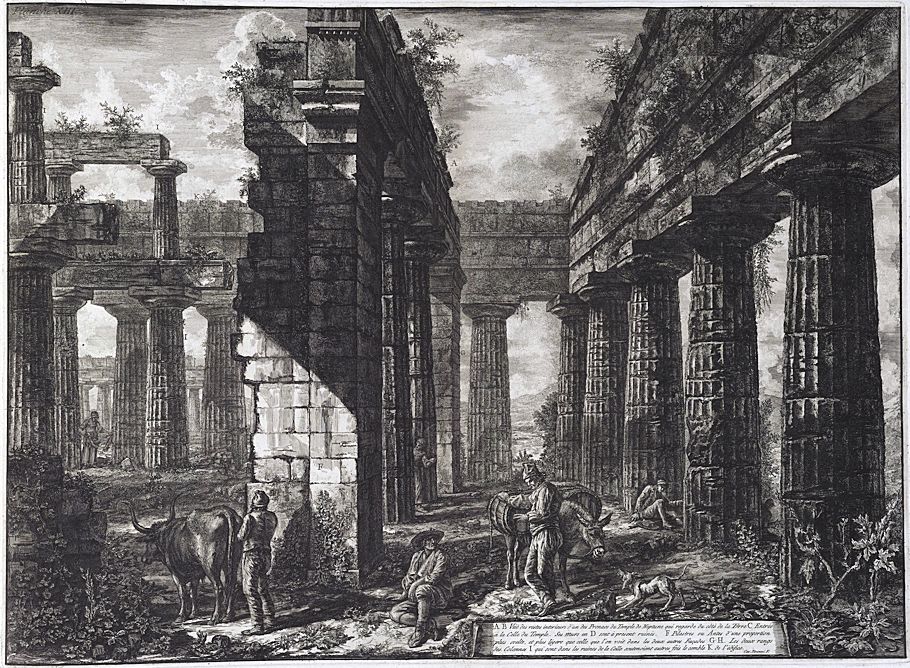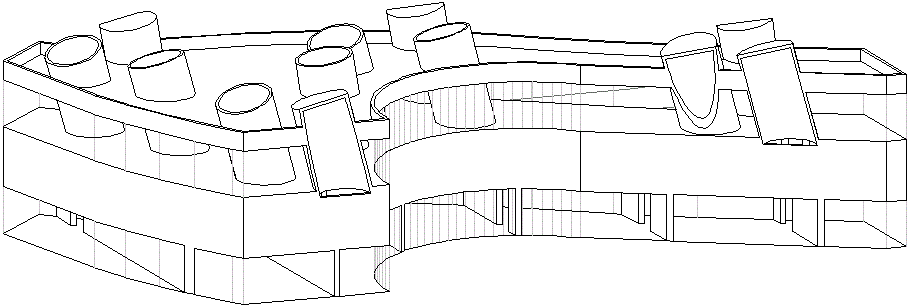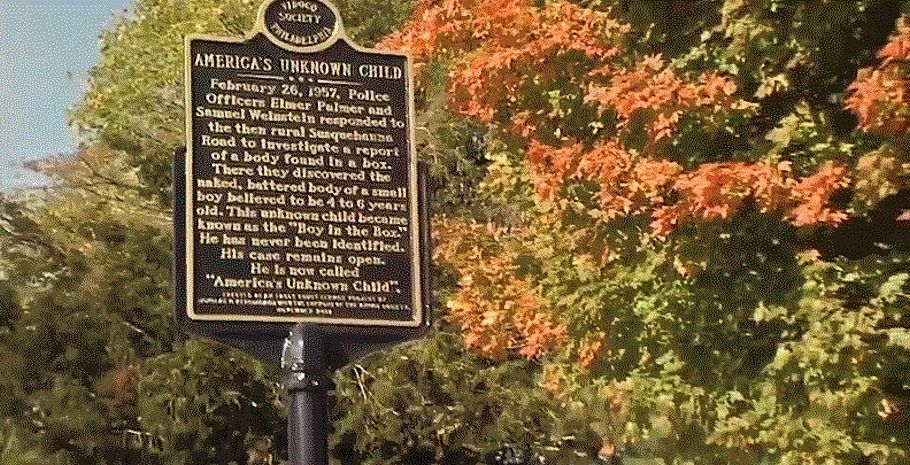14 December 1778 Monday

A B Vuë des restes interieurs d'un des Pronaos du Temple de Neptune qui regarde du cðté de la Terre C Entrée á la Celle du Temple. Ses Murs en D sont á present ruinés. F Pilastres ou Antes d'une proportion plus svelte, et plus légere que celle que l'on voit dans les deux autres Façades G H. Les deux rangs des Colonnes I qui sont dans les ruines de la Celle soutenoient autres fois le comble K de l'édifice. Cav. Piranesi F.
A B View of the interior remains of one of the Pronaos of the Temple of Neptune which looks towards the side of the Earth C Entrance to that of the Temple. Its D-walls are now ruined. F Pilasters or Antes of a more slender and lighter proportion than that seen in the other two Facades G H. The two rows of Columns I which are in the ruins of La Celle once supported the roof K the building.
14 December 1812 Monday

Morning opaque bluish clouds, wind drew to N, temperature in 36 degrees, out 32 degrees. Air sensibly moderated, wind abated, indications for snow upon my walk this morning. I discovered that the vane on my barn deceived me as to the course of the wind, the vale of the creek gives it a deflection out of its general course in the direction toward the barn. It had been from NW,W all day, and about 4 PM all the clouds were driven in the course over our zenith leaving the sky clear. The temperature rose to 38 degrees and the ground thawed somewhat in the shade after 12 noon. My neighbor J. Trump sent me Poorhouse Papers of Saturday in which there is intelligence via Boston from St. Petersburg as late as September 25th, from London October 21st and Liverpool 24th. The Russian army evacuated Moscow September 14th after having removed all the stores public and private, all the inhabitants and their property and set fire to it is 500 places. They retreated about 20 miles from it. The French entered the 15th and the 20th. Bulletin of the 17th states that 1600 churches, 100 palaces, immense magazines, and 30,000 sick and wounded Russians were burnt in it. No battle had been fought since that of Moskwa. It is stated that Napoleon had sent proposals of peace to Alexander, which he rejected and is determined to refuse all overtures while the enemy is in his country. Lord Calheart in his report of the Battle of Moskwa states the loss of the French at 40,000 men. The Russians in their first a... admit theirs's to be 25,000. Some alarms were excited at Petersburg. Alexander said there was no cause for fear, he had an army before it to repel the French and 3 armies he hired them to prevent their retreat. He permitted the timid to embark their property. A general battle was soon expected. May we not suppose this to be the last war, mentions Mathew 14,21,2: is it not astonishing beyond ...... wonder, that in this yet free country, the voice in the multitude calling themselves Republicans, should rejoice in the victories of this Emperor invading a country which was at peace with him and causing such destruction before him like the beard of a comet as was unknown in the times of Alexander, Caesar, Charlemagne, ........... or Kublia Khan? -- and that they should applaud and support with their suffrages a government that is carrying on a war in collateral aid of the invader against the only free government in the world our own excepted? Willberforce had declined a re-election to the British Parliament! which will be a sensible loss to that body -- his strict integrity, unwavered[?] .........., profound knowledge of parliamentary duties, his religious attachment to the constitution and laws of his country, unaffected piety, and blameless example in public and private life have marked him as one of the first men of the present reign. Where shall we find a worthy successor to stand in his place? Alas I know not the man! I have read the political book sent me by E. Roberts, 800 pages 173. It is written by a former partisan of the Prince Regent and states the situation of the country in three grand points of view. 1st in relation to the late disturbance in Nottingham, Yorkshire, etc. He considers them as approaching to civil war excited under pretense of non-employment of the manufacturers and scarcity of bread thru the operation of the Order in council, but he endeavors to show that they were political maneuvers encouraged by the Opposition if not raised by them. The author is extremely severe upon S.[?] France[?] and all the B......... whom he considers as too contemptible[?] to be very dangerous further than as a mob and suspects that their commotions have a higher origin. Whitebeard shares very strong suspicions and ......... under this head .... just is ....... at large and as ...... is .... to the danger a general pardon is recommended with few exceptions of high offences not named. 2nd under this head the late attempts to form an administration composed of members of all parties is explained at length. The conduct of the Prince is placed in a most amiable point of view and it shows that he did all that he could with the true spirit of conciliation to put an end to all the continuation of parties. It was shown that this was impossible and ......... are made to throw the whole blame upon Lord Grey and Greenville whose overbearing dispositions were intolerable in the course of the question of Catholic Emancipation, is placed in a luminous view entirely new to me. It is roundly asserted and rendered pretty clear to my understanding that the Catholics have obtained as much toleration as is consistent with the safety of the Protestants, that an annual Bill is past indemnifying them for non-conformity, but that they refuse to renounce the power of the Pope and the force of the Act of the Council of Lateran which declares all heretics (including the Protestants) to be ipso facto excommunicated and all temporal Lords are enjoined to exterminate them. Now says this writer, are the Catholics of Britain and Ireland entitled to .... political liberty while they are under the influence of this decree and of the clergy who are sworn to the influence of the Pope who is in the power of Napoleon? The writer answers his question in the negative and calls on the Catholics to renounce the Pope and the decrees of Lateran and others similar before they demand political power, or, in other words, to emancipate themselves from the power of the Pope and before they ask equal privileges with the Protestants -- In page 78 etc. there is a handsome address to the Children of America, descendants of Britains in the names of Penn, Franklin and Washington, ........ to peace -- The characters of Greenville and Grey are handsomely portrayed. The resources of the country are held out in glowing colors, with a grand eulogy on Pitt[?]. On the whole it is a glowing picture of the critical state of the country full of encouragement .......... to perseverance in the meaning of the new administration, etc.
14 December 2000
Language & Voice (and context)
...whenever I go to study an original edition of Piranesi's Campo Marzio publication, it is in a Frank Furness building, the Fine Arts Library of the University of Pennsylvania, the place where Louis Kahn held his design studios, and a building recently restored by Venturi, Scott Brown & Associates. Back in the mid-1980s, when I was employed as CAD system manager at U of P's Graduate School of Fine Arts, I had one the coveted balcony offices of Meyerson Hall which offer a majestic view of the Furness Fine Arts Library.
14 December 2003
Re: which Acropolis do you prefer?
the architecture at Giza is still slightly higher than the dome of San Pietro Vaticano though both ancient Egyptian and early Christian architecture excelled at building over places associated with dead people.
Re: which Acropolis do you prefer?
The explosion of the Parthenon occurred 26 September 1687. It would be interesting to know how many people on Earth 316 years from now will know the date of the attack on the World Trade Center off the top of their head.
Collective memory is a lot more selective than criticism.
For how long did the 'ideal' design of the Acropolis actually exist? Moreover, do we even fully understand what the Acropolis was really like while it manifest it's most ideal existence. For example, how was it all painted? Did a fair amount of the ideal design actually fade as soon as the colors did?
14 December 2008
Shape and Form
Louis Sullivan's form follows function argued against architecture's form having become too removed from its function--banks shouldn't look like ancient temples; bankers don't wear togas. When Sullivan was in Philadelphia working at Frank Furness' office, 1872-73, it was on the same block as, if not right across the street from, William Strickland's Second Bank of the United States, with very severe Doric temple fronts, 1819-24. Strickland's Philadelphia architecture was meant to represent the United States as the new democracy, thus emulating (reenacting) the architecture of the old democracy of ancient Greece. Note, however, the similarity of the contemporaneous works of Strickland and Schinkel point to other factors also being present within the formulation of Strickland's style, likely the influence of the "Grand Durand".
As it stands, the Second Bank of the United States is made of King of Prussia(n blue) marble.
Actually, the columns are crumbling due to having been originally hewn incorrectly.
"You mean form does not follow function when hewn incorrectly?!?"
14 December 2016

14 December 2022 Wednesday

This historical marker is just up my street and around the corner.
|